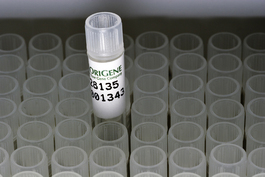DC SIGN (CD209) (NM_001144894) Human Untagged Clone
CAT#: SC325823
CD209 (untagged)-Human CD209 molecule (CD209), transcript variant 6
"NM_001144894" in other vectors (4)
Product Images

Specifications
| Product Data | |
| Type | Human Untagged Clone |
| Tag | Tag Free |
| Symbol | CD209 |
| Synonyms | CDSIGN; CLEC4L; DC-SIGN; DC-SIGN1 |
| Vector | pCMV6 series |
| Sequence Data |
>NCBI ORF sequence for NM_001144894, the custom clone sequence may differ by one or more nucleotides
ATGAGTGACTCCAAGGAACCAAGACTGCAGCAGCTGGGCCTCCTGGTGTCCAAGGTCCCC AGCTCCATAAGTCAGGAACAATCCAGGCAAGACGCGATCTACCAGAACCTGACCCAGCTT AAAGCTGCAGTGGGTGAGCTCTCAGAGAAATCCAAGCTGCAGGAGATCTACCAGGAGCTG ACCCAGCTGAAGGCTGCAGTGGGTGAGCTTCCAGAGAAATCTAAGCTGCAGGAGATCTAC CAGGAGCTGACCCGGCTGAAGGCTGCAGTGGGTGAGCTTCCAGAGAAATCTAAGCTGCAG GAGATCTACCAGGAGCTGACCTGGCTGAAGGCTGCAGTGGGTGAGCTTCCAGAGAAATCT AAGATGCAGGAGATCTACCAGGAGCTGACTCGGCTGAAGGCTGCAGTGGGTGAGCTTCCA GAGAAATCTAAGCAGCAGGAGATCTACCAGGAGCTGACCCGGCTGAAGGCTGCAGTGGGT GAGCTTCCAGAGAAATCTAAGCAGCAGGAGATCTACCAGGAGCTGACCCGGCTGAAGGCT GCAGTGGGTGAGCTTCCAGAGAAATCTAAGCAGCAGGAGATCTACCAGGAGCTGACCCAG CTGAAGGCTGCAGTGGAACGCCTGTGCCACCCCTGTCCCTGGGAATGGACATTCTTCCAA GGAAACTGTTACTTCATGTCTAACTCCCAGCGGAACTGGCACGACTCCATCACCGCCTGC AAAGAAGTGGGGGCCCAGCTCGTCGTAATCAAAAGTGCTGAGGAGCAGAACTTCCTACAG CTGCAGTCTTCCAGAAGTAACCGCTTCACCTGGATGGGACTTTCAGATCTAAATCAGGAA GGCACGTGGCAATGGGTGGACGGCTCACCTCTGTTGCCCAGCTTCAAGCAGTATTGGAAC AGAGGAGAGCCCAACAACGTTGGGGAGGAAGACTGCGCGGAATTTAGTGGCAATGGCTGG AACGACGACAAATGTAATCTTGCCAAATTCTGGATCTGCAAAAAGTCCGCAGCCTCCTGC TCCAGGGATGAAGAACAGTTTCTTTCTCCAGCCCCTGCCACCCCAAACCCCCCTCCTGCG |
| Restriction Sites | Please inquire |
| ACCN | NM_001144894 |
| ORF Size | 1083 bp |
| OTI Disclaimer | Our molecular clone sequence data has been matched to the reference identifier above as a point of reference. Note that the complete sequence of our molecular clones may differ from the sequence published for this corresponding reference, e.g., by representing an alternative RNA splicing form or single nucleotide polymorphism (SNP). |
| OTI Annotation | This TrueClone is provided through our Custom Cloning Process that includes sub-cloning into OriGene's pCMV6 vector and full sequencing to provide a non-variant match to the expected reference without frameshifts, and is delivered as lyophilized plasmid DNA. |
| Reference Data | |
| RefSeq | NM_001144894.1, NP_001138366.1 |
| RefSeq Size | 4196 |
| RefSeq ORF | 1083 |
| Locus ID | 30835 |
| Protein Families | Druggable Genome |
| Gene Summary | This gene encodes a transmembrane receptor and is often referred to as DC-SIGN because of its expression on the surface of dendritic cells and macrophages. The encoded protein is involved in the innate immune system and recognizes numerous evolutionarily divergent pathogens ranging from parasites to viruses with a large impact on public health. The protein is organized into three distinct domains: an N-terminal transmembrane domain, a tandem-repeat neck domain and C-type lectin carbohydrate recognition domain. The extracellular region consisting of the C-type lectin and neck domains has a dual function as a pathogen recognition receptor and a cell adhesion receptor by binding carbohydrate ligands on the surface of microbes and endogenous cells. The neck region is important for homo-oligomerization which allows the receptor to bind multivalent ligands with high avidity. Variations in the number of 23 amino acid repeats in the neck domain of this protein are rare but have a significant impact on ligand binding ability. This gene is closely related in terms of both sequence and function to a neighboring gene (GeneID 10332; often referred to as L-SIGN). DC-SIGN and L-SIGN differ in their ligand-binding properties and distribution. Alternative splicing results in multiple variants. [provided by RefSeq, Feb 2009] Transcript Variant: This variant (6) lacks multiple exons in the coding region but maintains the reading frame, compared to variant 1. The encoded isoform (6) is shorter and lacks the transmembrane domain compared to isoform 1. Sequence Note: This record was created from transcript and genomic sequence data to make the sequence consistent with the reference genome assembly. The genomic coordinates used for the transcript record were based on transcript alignments. |
Documents
| Product Manuals |
| FAQs |
| SDS |
Resources
Other Versions
| SKU | Description | Size | Price |
|---|---|---|---|
| RC227875 | CD209 (Myc-DDK-tagged)-Human CD209 molecule (CD209), transcript variant 6. Note: ORF is codon optimized |
USD 420.00 |
|
| RG227875 | CD209 (GFP-tagged) - Human CD209 molecule (CD209), transcript variant 6. Note: ORF is codon optimized |
USD 460.00 |
|
| RC227875L3 | Lenti-ORF clone of CD209 (Myc-DDK-tagged)-Human CD209 molecule (CD209), transcript variant 6. Note: ORF is codon optimized |
USD 620.00 |
|
| RC227875L4 | Lenti-ORF clone of CD209 (mGFP-tagged)-Human CD209 molecule (CD209), transcript variant 6. Note: ORF is codon optimized |
USD 620.00 |
{0} Product Review(s)
Be the first one to submit a review






























































































































































































































































 Germany
Germany
 Japan
Japan
 United Kingdom
United Kingdom
 China
China
